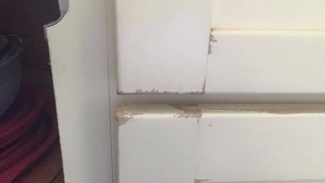

Even though there is internet chatter about removing wax with 3rd party products, mineral spirits or vinegar, none guarantee success.
There is an old saying in the industry. "Once you wax, you cannot go back". Nothing adheres well to wax and even after cleaning, the wood grain can become contaminated. Wax can penetrate the wood, making future paint or stain finishes or touch-ups difficult or impossible.
There are several reasons:
1. The cabinets were not prep cleaned and sanded properly. Sanding and cleaning are an essential part of any refinishing process.
In most cases, you can use a 220 sanding pad to scuff the surface and clean with a 50|50 mix of water and denatured alcohol.
If your current finish is chipping, it is failing to adhere correctly. The adhesion problem could be caused by several reasons:

If your current finish is chipping, it is failing to adhere correctly. The adhesion problem could be caused by several reasons:
This response is true of prepping and existing finish on furniture, but kitchen cabinets are more problematic because they are work areas where grease, steam, food splatters and oil from hands are common. Prep is basically degreasing and abrading the surface for better adhesion. Oil or substances on hands really show up on a failed re-finish around doorknobs and hands if the surface is not cleaned thoroughly.
There is no easy solution to this problem. General Finishes Milk Paint has strong adhesion properties but there are several reasons this finish could fail:
Satin Finishing Wax is a special blend of waxes designed to give finished woods a rich luster. It can be used as a polish for rubbing out new finishes or as a scratch-remover for worn surfaces. It works well over oil and water-based finishes, including Danish Oil.
GF advises extra care and prep when applying any finish over laminate surfaces because they are specifically designed not to mar and therefore they are not very "sand-able", making adherence difficult.
In addition to this non-permeable surface factor, General Finishes Gel Stain is an oil-based product, and it is more difficult to obtain proper drying characteristics over a dense manufactured surface such as laminate. Gel stains, as all wood stains, were formulated to go over raw wood which has an "open" surface and can absorb some of the stain.
There are no guarantees with silicone - it is almost impossible to remove. If the silicone has migrated into the wood through cracks in the old finish, you may not be able to get it all removed.
Unfortunately, silicone contaminants, often from dusting sprays, do not become apparent until a new finish is applied and generally cannot be removed from the surface, only moved around and possibly sealed - a bane of the refinishing industry.
You need to power clean the existing finish and put on some type of barrier coat:
Should I use a topcoat or a wax over my paint or stain finish?
The GF gang gets this question all the time.